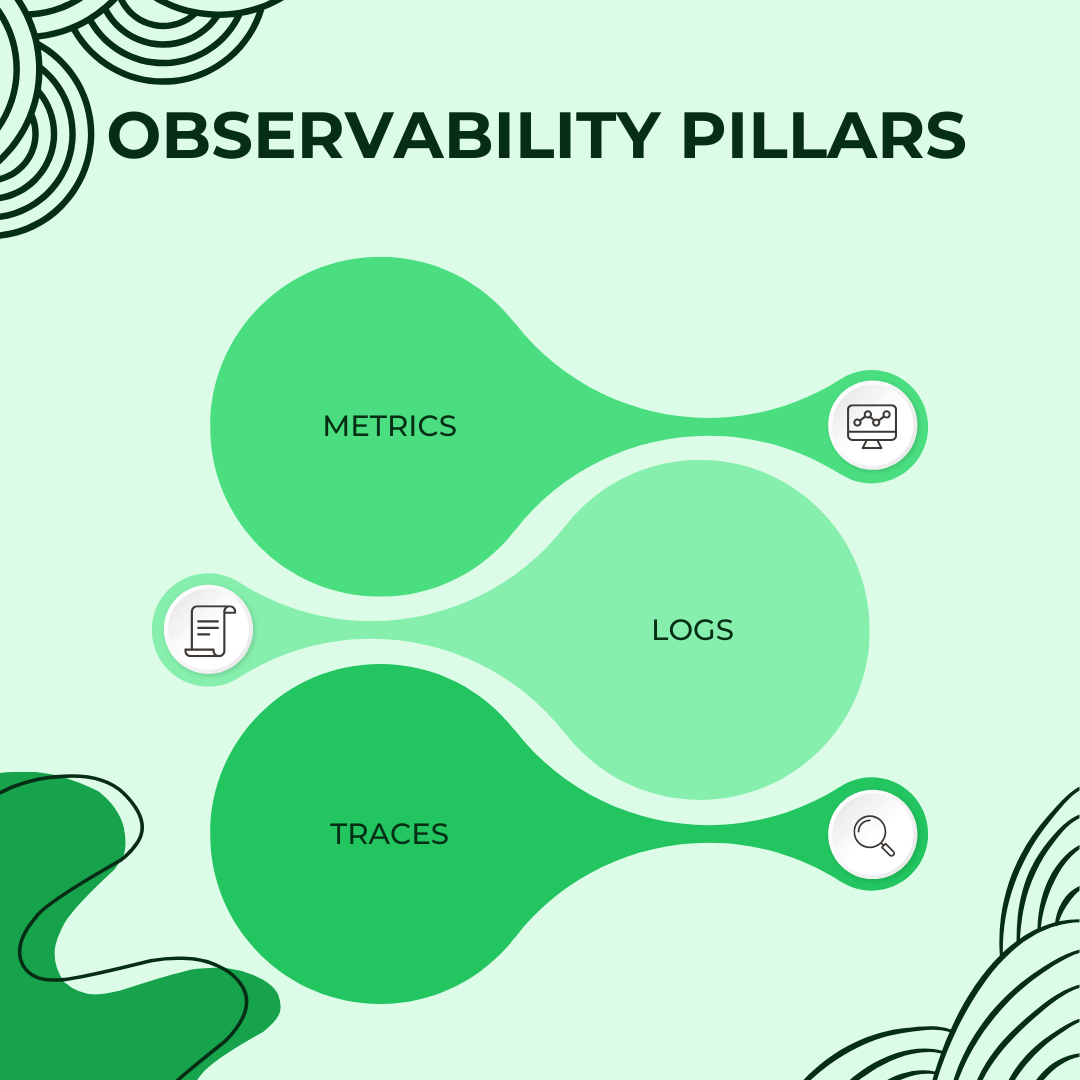Introduction
Managing complex IT systems often leads to challenges in maintaining reliability and performance. Traditional monitoring methods can fall short, leaving teams struggling to diagnose issues effectively. Observability offers a solution by providing a comprehensive view of system behavior through metrics, logs, and traces.
This article explores how augmenting your Site Reliability Engineering (SRE) practices with observability can enhance system reliability and performance, ensuring you meet your operational goals efficiently.
Understanding Observability
Observability is a critical component in modern IT and SRE practices, offering a profound way to gain insights into system performance and behavior. Unlike traditional monitoring, which primarily focuses on predefined metrics and alerts, observability provides a more comprehensive view by enabling the exploration of internal states and dynamic aspects of complex systems.
At its core, observability is defined by its ability to answer complex questions about a system’s performance and issues based on the data collected. This capability is crucial for diagnosing problems that are not immediately apparent through standard monitoring methods.
Components of Observability
Observability is built upon three key pillars: metrics, logs, and traces.
- Metrics: These are quantitative measures that track system performance, such as response times, error rates, and throughput. Metrics provide a high-level view of system health and can trigger alerts when thresholds are breached, but they often require deeper context to understand underlying issues.
- Logs: Logs are detailed records of events and transactions within a system. They offer granular insights into operations, making them invaluable for troubleshooting specific issues. Centralized logging systems aggregate and manage these logs, enabling efficient searching and analysis.
- Traces: Traces represent the end-to-end journey of a request through various system components. Distributed tracing helps visualize and analyze how requests propagate across services, identifying bottlenecks and performance issues.
By integrating these components, observability empowers SRE teams to proactively address challenges, optimize system reliability, and ensure a smoother, more responsive user experience. Embracing observability means moving beyond surface-level metrics to a deeper understanding of your system’s intricate dynamics.
The Role of Observability in SRE
Observability plays a pivotal role in Site Reliability Engineering (SRE) by enhancing the effectiveness of SRE practices and driving improved system reliability and performance. It aligns seamlessly with the core principles of SRE, which emphasize maintaining high service levels and managing complex systems.
Support for SRE Practices
Observability supports SRE principles by providing the tools necessary to measure and meet Service Level Indicators (SLIs), Service Level Objectives (SLOs), and Service Level Agreements (SLAs).
Through detailed metrics, logs, and traces, observability enables teams to set precise SLOs, monitor performance against these targets, and swiftly address any deviations. This alignment ensures that systems remain reliable and performance expectations are met consistently.
Enhancing Reliability through Data-Driven Insights
By integrating observability into SRE practices, teams gain access to comprehensive data that enhances their ability to diagnose and resolve issues.
Observability tools provide real-time visibility into system health, allowing for quick identification of problems and their root causes. This proactive approach helps prevent outages and reduces downtime, thus improving overall system reliability.
Observability Pillars
The three pillars of observability—metrics, logs, and traces—each play a distinct role in supporting SRE initiatives:
- Metrics offer a high-level view of system performance and health, aiding in monitoring and alerting.
- Logs provide detailed context and historical data, which is crucial for in-depth troubleshooting.
- Traces allow for end-to-end visibility into requests, highlighting performance bottlenecks and inefficiencies.
Incorporating observability into SRE practices transforms how teams interact with their systems, moving from reactive to proactive management. This shift enables a more resilient and responsive approach to maintaining service reliability and enhancing user satisfaction.

Benefits of Enhanced Observability
Enhanced observability brings significant advantages to Site Reliability Engineering (SRE) practices, profoundly impacting incident response, system reliability, and user experience.
Improved Incident Response and Troubleshooting
One of the foremost benefits of enhanced observability is its impact on incident response. With detailed metrics, logs, and traces at your disposal, SRE teams can quickly identify and address issues before they escalate.
Real-time visibility into system performance allows for rapid detection of anomalies and a deeper understanding of their root causes. This capability not only speeds up troubleshooting but also reduces the time to resolution, minimizing service disruptions and maintaining operational continuity.
Increased System Reliability and Performance
Observability enhances system reliability by providing actionable insights that help prevent and mitigate potential failures. Continuous monitoring of performance metrics enables teams to identify trends and proactively address potential issues. Observability tools also facilitate performance tuning by revealing inefficiencies and bottlenecks, allowing for targeted improvements. As a result, systems become more robust, with higher uptime and improved overall performance, leading to a more stable and reliable service.
Better User Experience
The ultimate goal of enhancing observability is to improve the user experience. By ensuring systems run smoothly and issues are resolved swiftly, observability directly contributes to user satisfaction. A reliable and performant system translates to fewer disruptions and a more consistent experience for end-users.
Enhanced observability helps in identifying areas that impact user experience negatively and allows for timely interventions, ensuring that users encounter fewer issues and enjoy a more seamless interaction with the service.
Implementing Observability in SRE
Integrating observability into Site Reliability Engineering (SRE) practices requires a strategic approach to ensure effective deployment and utilization. Here’s how to successfully implement observability in your SRE processes.
Integration Steps
- Choosing the Right Tools: Begin by selecting observability tools that fit your specific needs and infrastructure. Evaluate options based on their ability to collect and analyze metrics, logs, and traces. Popular tools include Prometheus for metrics, Elasticsearch for logs, and Jaeger or Zipkin for tracing.
- Setting Up Observability Frameworks: Implement frameworks that support the seamless collection and correlation of data. Establish data pipelines that integrate with your existing systems and ensure that data flows from various sources into a centralized observability platform.
Best Practices
- Define Clear Goals: Establish clear objectives for what you aim to achieve with observability. This could include improving incident response times, enhancing performance monitoring, or achieving specific reliability targets.
- Ensure Data Quality: Focus on collecting high-quality, relevant data. Avoid data overload by filtering out noise and focusing on metrics and logs that provide actionable insights. Regularly review and refine data collection practices to maintain relevance.
- Regular Reviews and Adjustments: Regularly evaluate the impact of your observability strategy. Use feedback from incident responses and performance monitoring to fine-tune your setup, adjust thresholds, and optimize data collection.
Common Pitfalls
- Data Overload: One common issue is an overload of data, which can obscure critical information. Implement strategies to manage and prioritize data effectively.
- Tool Complexity: Overly complex tools can lead to challenges in integration and usage. Choose tools that offer a balance between functionality and ease of use.
Case Studies and Real-World Examples
Exploring real-world examples of organizations that have successfully integrated observability into their Site Reliability Engineering (SRE) practices provides valuable insights into its practical benefits and implementation strategies.
Success Stories
- Netflix: Netflix uses observability extensively to manage its microservices architecture. They leverage tools like Prometheus for metrics and Jaeger for tracing to monitor system performance and quickly diagnose issues. Their observability practices have significantly enhanced their ability to handle large-scale operations and ensure high service reliability.
- Google: Google integrates observability into its SRE practices through its internal tools and systems, such as Borgmon for monitoring and Dapper for tracing. These tools provide deep insights into system performance and help maintain the reliability and efficiency of their services.
- Slack: Slack uses observability tools to manage its rapidly growing infrastructure. They utilize a combination of metrics, logs, and traces to gain comprehensive visibility into their systems, which helps them maintain high availability and optimize performance.
Lessons Learned
- Importance of Data Quality: Both companies learned that high-quality, relevant data is crucial for effective observability. Filtering out noise and focusing on actionable metrics helped them avoid data overload and maintain clear insights.
- Tool Integration Challenges: Integrating observability tools with existing systems was a challenge for both organizations. They found that careful planning and phased implementation helped mitigate integration issues and ensured a smoother transition.
Key Takeaways
- Observability Enhances SRE: Integrating observability improves incident response, system reliability, and overall performance by providing deep insights into system behavior.
- Three Pillars of Observability: Metrics, logs, and traces are essential for comprehensive monitoring and troubleshooting.
- Proactive Issue Management: Observability allows for early detection and resolution of issues, reducing downtime and improving system stability.
- Real-World Impact: Successful implementation of observability tools can significantly enhance incident management and performance, as demonstrated by companies like Netflix and Google.
- Implementation Best Practices: Focus on selecting the right tools, ensuring data quality, and regularly reviewing and adjusting observability practices for optimal results.
Conclusion
Observability is essential for advancing Site Reliability Engineering (SRE), offering deeper insights through metrics, logs, and traces. By integrating observability, teams can enhance incident response, boost system reliability, and improve user experience.
Real-world examples, like those from Netflix and Google, demonstrate its effectiveness in optimizing performance and managing complex systems. For successful implementation, select the right tools, ensure high-quality data, and regularly refine your strategy. Embracing observability will elevate your SRE practices and ensure better system reliability and user satisfaction.

